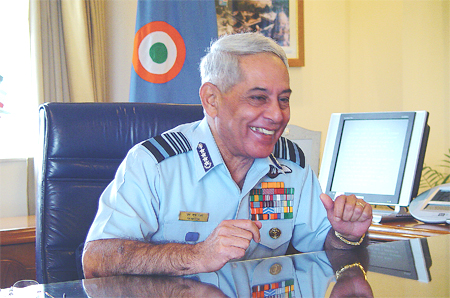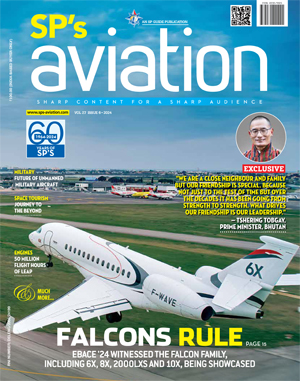INDIAN ARMED FORCES CHIEFS ON
OUR RELENTLESS AND FOCUSED PUBLISHING EFFORTS

SP Guide Publications puts forth a well compiled articulation of issues, pursuits and accomplishments of the Indian Army, over the years

I am confident that SP Guide Publications would continue to inform, inspire and influence.

My compliments to SP Guide Publications for informative and credible reportage on contemporary aerospace issues over the past six decades.
CAS - Space-based assets essential force multipliers

In the concluding portion of the interview of the Chief of the Air Staff, Air Chief Marshal F.H. Major, Editor-in-Chief Jayant Baranwal and Senior Visiting Editor Air Marshal (Retd) V.K. Bhatia draw out his opinions and views on a vast range of issues pertaining to the development, equipment and enhancement of the force.
SP’s Aviation (SP’s): Participation by the Indian Air Force (IAF) in international air exercises, including Exercise Red Flag 2008 in the US, has amply proved the force’s capability of strategic reach, albeit on a small scale. Are there any plans to enhance this capability to meet the demands in the future?
Chief of the Air Staff (CAS): Today, India is a resurgent nation with a growing economy and seeks to enlarge its area of influence. It is but natural that India will need to project power in order to safeguard its interests at the extremities of these areas. The IAF seeks to develop credible capability across the spectrum of conflict and demonstrate strategic reach so as to safeguard national interests. Our plans will remain within the context of this requirement.
SP’s: How is the IAF equipping itself to achieve its stated core competencies pertaining to precision attack and allweather capabilities?
CAS: The ability to deliver hard power, with precision and under all conditions, is an essential capability of the IAF. The IAF has planned its future acquisitions keeping this factor in mind. To achieve this, all combat platforms which are being acquired will possess the capability in terms of avionics and aids to deliver ordnance under all conditions. We are also acquiring weapons of compatible capability that can be delivered with precision and under all weather conditions. We also continue to train and refine our tactics constantly so as to maintain a high level of proficiency, in the delivery of these specialist weapons.
SP’s: The aerospace industry in India, you have often stressed, cannot be managed as just a public sector outfit and the defence industry is keen on integration with the private sector for achieving self-reliance. How can the IAF help in achieving the desired goals?
CAS: The IAF is very supportive of the government’s effort to encourage private defence industry. We must admit that the Indian defence industry has largely been confined to public sector units and has been sheltered for far too long. The situation in India after Independence did warrant such measures and there were definitely justifiable reasons then. Today, whilst the defence PSUs continue to serve the nation well, the pace of change demands faster response time and an infusion of fresh energy. The private sector in India today possesses immense capability and we feel that it must be actively involved in the process of manufacture of defence products. The Defence Procurement Policy 2008 (DPP-08) has made many provisions to encourage the participation of private industry and these must be utilised. It permits partnerships and joint ventures with foreign companies, as also licence productions. The offset clause will require a re-investment of 30 to 50 per cent of the contracted amount back into the country. The IAF interacts very regularly at all levels with the private industry and its requirements are regularly communicated at various levels. There is a lot of interaction with the Confederation of Indian Industries and institutional steps have been formalised to cement this relationship. We recently held a seminar, INDAIR-08, which helped us understand each others perspectives and laid the foundations for increasing partnerships.
SP’s: It is heartening to see the convergence of interests between the Ministries of Defence and Civil Aviation with regard to sharing each other’s infrastructure facilities and airspace. Could you give an update, especially on the concept of flexi use of airspace?
CAS: The IAF recognises the growing demands of the civil aviation sector in our country. The force operates a number of bases in the country, and has a certain volume of airspace earmarked for military training. This airspace is required for our combat assets to carry out routine training to maintain the required level of operational preparedness. The IAF has gone out of its way to accommodate the needs of the civil aviation industry. At the moment, 19 major airfields of the IAF are used by regular commercial airlines. Nearly 250 flights operate from these bases daily. In fact, Pune and Agra now operate on a 24x7 hour basis to accommodate commercial traffic.
All our airfields, including frontline ones like Srinagar and Jaisalmer, which are run by the IAF, are fully supportive of commercial operations. The IAF has also deputed, often at very short notice, its ATC officers, fire fighters and other supporting operational staff at various civil aerodromes, whenever required, to enable commercial operations.
In fact, it is the Indian Air Force that initiated the concept of flexible use of airspace. Whenever our airspace is not in use, we permit civil flights to transit through, thus reducing time and fuel consumption. In a similar manner, IAF aircraft could use civil airspace and routes when available. Such an arrangement would be of mutual benefit. We have tried this out very successfully in the southern sector.
SP’s: It is rumoured that the Hawk fleet is afflicted with serious problems of quality and product support resulting in low serviceability with adverse effect on training. How is the IAF coping with this situation?
CAS: There have been a few teething problems in the induction phase of the Hawk. But I think that is to be expected in a project of such nature. We have taken very active steps in co-ordination with Hindustan Aeronautics Limited and BAE Systems to overcome the issues that have affected operations. The response has been very positive and the supply of spares and providing specialist teams for rectification and maintenance, have been addressed. As many as 18 pilots have finished training on Hawks at Bidar.





